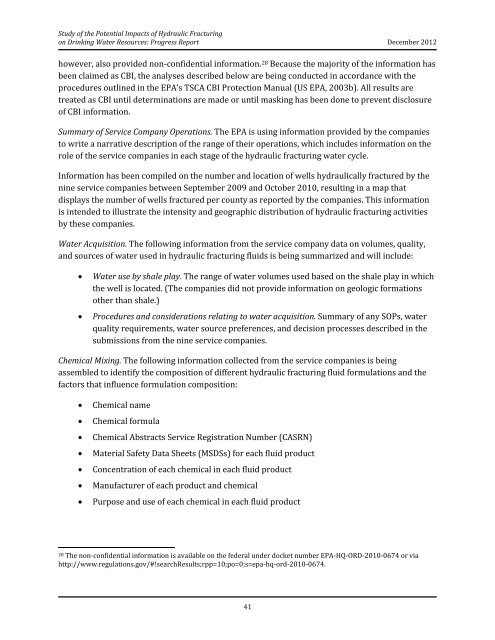hf-report20121214
hf-report20121214
hf-report20121214
Create successful ePaper yourself
Turn your PDF publications into a flip-book with our unique Google optimized e-Paper software.
Study of the Potential Impacts of Hydraulic Fracturing<br />
on Drinking Water Resources: Progress Report December 2012<br />
however, also provided non-confidential information. 28 Because the majority of the information has<br />
been claimed as CBI, the analyses described below are being conducted in accordance with the<br />
procedures outlined in the EPA’s TSCA CBI Protection Manual (US EPA, 2003b). All results are<br />
treated as CBI until determinations are made or until masking has been done to prevent disclosure<br />
of CBI information.<br />
Summary of Service Company Operations. The EPA is using information provided by the companies<br />
to write a narrative description of the range of their operations, which includes information on the<br />
role of the service companies in each stage of the hydraulic fracturing water cycle.<br />
Information has been compiled on the number and location of wells hydraulically fractured by the<br />
nine service companies between September 2009 and October 2010, resulting in a map that<br />
displays the number of wells fractured per county as reported by the companies. This information<br />
is intended to illustrate the intensity and geographic distribution of hydraulic fracturing activities<br />
by these companies.<br />
Water Acquisition. The following information from the service company data on volumes, quality,<br />
and sources of water used in hydraulic fracturing fluids is being summarized and will include:<br />
• Water use by shale play. The range of water volumes used based on the shale play in which<br />
the well is located. (The companies did not provide information on geologic formations<br />
other than shale.)<br />
• Procedures and considerations relating to water acquisition. Summary of any SOPs, water<br />
quality requirements, water source preferences, and decision processes described in the<br />
submissions from the nine service companies.<br />
Chemical Mixing. The following information collected from the service companies is being<br />
assembled to identify the composition of different hydraulic fracturing fluid formulations and the<br />
factors that influence formulation composition:<br />
• Chemical name<br />
• Chemical formula<br />
• Chemical Abstracts Service Registration Number (CASRN)<br />
• Material Safety Data Sheets (MSDSs) for each fluid product<br />
• Concentration of each chemical in each fluid product<br />
• Manufacturer of each product and chemical<br />
• Purpose and use of each chemical in each fluid product<br />
28 The non-confidential information is available on the federal under docket number EPA-HQ-ORD-2010-0674 or via<br />
http://www.regulations.gov/#!searchResults;rpp=10;po=0;s=epa-hq-ord-2010-0674.<br />
41


